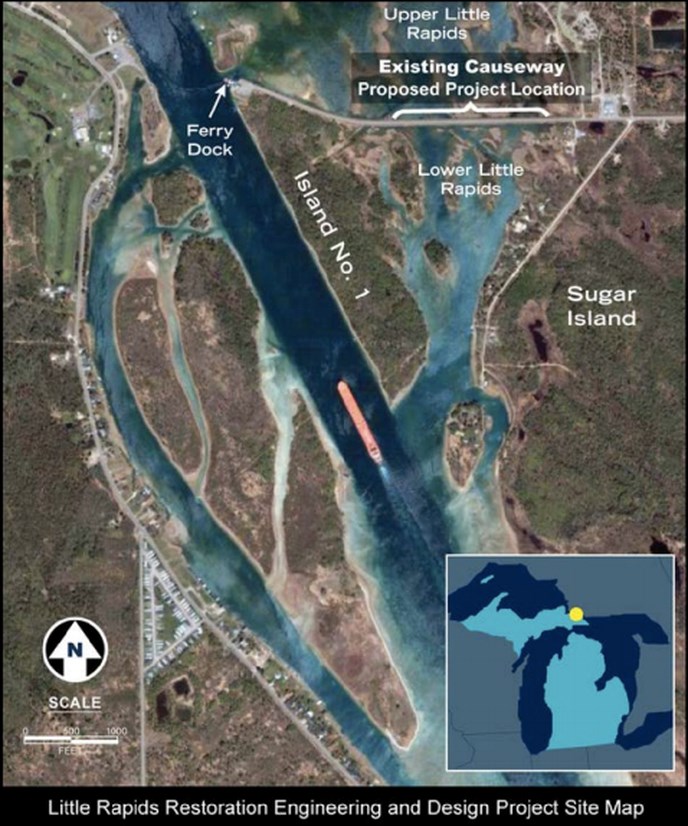NEWS RELEASE
BOARD OF COUNTY ROAD COMMISSIONERS OF THE COUNTY OF CHIPPEWA
*************************
The Little Rapids Restoration Project celebrated a huge milestone as traffic shifted from a temporary construction road to a new 600-foot-long bridge. The first non-construction related car passed over the bridge on Friday, Oc. 21, 2016.
It took a lot of coordination, collaboration, and education from the project team to complete this magnitude of work.
“The project wrapped up for the season about two weeks ahead of schedule” said Chippewa County Road Commission Superintendent-Manager Robert Laitinen. He attributes a large part of the success of this project to the fact that “Payne and Colon and Zenith Tech have been exceptional contractors to work with."
Laitinen further added that “to complete a project of this size, on time and within budget, is a pretty rare occurrence, and we are well within the range of achieving that goal." Next spring, workers will return to complete some minor paving at the approaches to the bridge, restore any disturbed vegetated areas, and finish site clean-up.
Bridge construction started in spring 2016 and the contractors, Payne and Dolan Inc. and Zenith Tech Inc., have moved at a rapid pace to minimize the impact to local residents.
The Chippewa County Road Commission owns the causeway and is leading construction efforts. Construction began with the installation of a temporary road for public use during the removal of the existing causeway and erection of a new bridge structure.
Once the new bridge was in place and safe for public use, traffic was shifted to the new bridge, bringing the project to substantial completion status.
Removal of the temporary road and other site clean-up was also completed this fall. Lake Superior State University’s Aquatic Research Center will continue ecological monitoring in the river in 2017 to measure project successes.
Members of the community have been advocating for this project for more than two decades and we're glad NOAA was able to provide funding through the Great Lakes Restoration Initiative," said Julie Sims,
Regional Coordinator with NOAA’s Restoration Center.” This project will increase fish habitat for species such as lake whitefish, lake sturgeon, and walleye."
Access between Sault Ste. Marie and Sugar Island historically required travel on a causeway that funneled water through two deteriorating undersized culverts.
The construction of a new bridge allows free flow of the St. Marys River and will result in increased fish and wildlife habitat while improving local infrastructure and pedestrian access.
The Little Rapids were historically some of the most productive spawning grounds in the Great Lakes for sport fish and completion of this project will improve the ecological, community and economic value of the St. Marys River.
The St. Marys River was designated an Area of Concern (AOC), or "toxic hotspot", in 1987 and progress has been made in subsequent years in both the U.S. and Canada to improve a number of environmental conditions.
This is the final anticipated project necessary to address habitat-related Beneficial Use Impairments at the St. Marys River and the last anticipated project for the U. S. side of the AOC.
This project is funded by the National Oceanic and Atmospheric Administration (NOAA) through the Great Lakes Restoration Initiative and a partnership with the Great Lakes Commission (GLC). The GLRI is the largest federal investment in the Great Lakes in the last two decades.
Planning for the Little Rapids Restoration Project began in 1992 with the Soo Area Sportsmen’s Club and integrated the perspective of many local, state and federal partners including NOAA, GLC, Chippewa County Road Commission, Eastern Upper Peninsula Regional Planning and Development Commission, Lake Superior State University, Chippewa Ottawa Resource Authority, Michigan Departments of Environmental Quality and Natural Resources, and the U. S. Environmental Protection Agency.
The overall AOC de-listing process is guided by the St. Marys River Binational Public Advisory Council.
To learn more about this project, visit the EUPRPDC website or the Little Rapids Restoration and Chiopewa County Road Commission Facebook pages.
*************************
